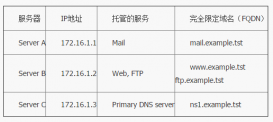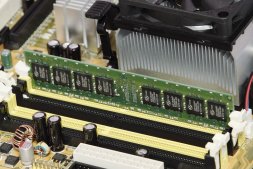Linux的硬盘识别:
一般使用”fdisk -l”命令可以列出系统中当前连接的硬盘
设备和分区信息.新硬盘没有分区信息,则只显示硬盘大小信息.
1.关闭服务器加上新硬盘
2.启动服务器,以root用户登录
3.查看硬盘信息
|
1
|
#fdisk -l |
|
1
2
3
4
5
6
7
8
9
10
11
12
13
14
15
16
17
18
19
20
21
|
Disk /dev/sda: 42.9 GB, 42949672960 bytes 255 heads, 63 sectors/track, 5221 cylinders Units = cylinders of 16065 * 512 = 8225280 bytes Sector size (logical/physical): 512 bytes / 512 bytes I/O size (minimum/optimal): 512 bytes / 512 bytes Disk identifier: 0x0004406e Device Boot Start End Blocks Id System /dev/sda1 * 1 39 307200 83 Linux Partition 1 does not end on cylinder boundary. /dev/sda2 39 2589 20480000 83 Linux /dev/sda3 2589 2850 2097152 82 Linux swap / Solaris /dev/sda4 2850 5222 19057664 5 Extended /dev/sda5 2850 5222 19056640 83 Linux Disk /dev/sdb: 10.7 GB, 10737418240 bytes 255 heads, 63 sectors/track, 1305 cylinders Units = cylinders of 16065 * 512 = 8225280 bytes Sector size (logical/physical): 512 bytes / 512 bytes I/O size (minimum/optimal): 512 bytes / 512 bytes Disk identifier: 0x14b52796 Device Boot Start End Blocks Id System |
4.创建新硬盘分区命令参数:
fdisk可以用m命令来看fdisk命令的内部命令;
- a:命令指定启动分区;
- d:命令删除一个存在的分区;
- l:命令显示分区ID号的列表;
- m:查看fdisk命令帮助;
- n:命令创建一个新分区;
- p:命令显示分区列表;
- t:命令修改分区的类型ID号;
- w:命令是将对分区表的修改存盘让它发生作用。
5.进入磁盘,对磁盘进行分区,注意红色部分。
|
1
|
#fdisk /dev/sdb |
|
1
2
3
4
5
6
7
8
9
10
11
|
Command (m for help):n Command action e extended //输入e为创建扩展分区 p primary partition (1-4) //输入p为创建逻辑分区 p Partion number(1-4):1 //在这里输入l,就进入划分逻辑分区阶段了; First cylinder (51-125, default 51): //注:这个就是分区的Start 值;这里最好直接按回车,如果您输入了一个非默认的数字,会造成空间浪费; Using default value 51 Last cylinder or +size or +sizeM or +sizeK (51-125, default 125): +200M 注:这个是定义分区大小的,+200M 就是大小为200M ;当然您也可以根据p提示的单位cylinder的大小来算,然后来指定 End的数值。回头看看是怎么算的;还是用+200M这个办法来添加,这样能直观一点。如果您想添加一个10G左右大小的分区,请输入 +10000M ; Command (m for help): w //最后输入w回车保存。 |
查看一下:
|
1
|
#fdisk -l |
可以看到/dev/sdb1分区,我就省略截图咯。
6.格式化分区:
|
1
|
#mkfs.ext3 /dev/sdb1 //注:将/dev/sdb1格式化为ext3类型 |
|
1
2
3
4
5
6
7
8
9
10
11
12
13
14
15
16
17
18
19
20
21
22
|
mke2fs 1.41.12 (17-May-2010) 文件系统标签= 操作系统:Linux 块大小=4096 (log=2) 分块大小=4096 (log=2) Stride=0 blocks, Stripe width=0 blocks 640848 inodes, 2562359 blocks 128117 blocks (5.00%) reserved for the super user 第一个数据块=0 Maximum filesystem blocks=2625634304 79 block groups 32768 blocks per group, 32768 fragments per group 8112 inodes per group Superblock backups stored on blocks: 32768, 98304, 163840, 229376, 294912, 819200, 884736, 1605632 正在写入inode表: 完成 Creating journal (32768 blocks): 完成 Writing superblocks and filesystem accounting information: 完成 This filesystem will be automatically checked every 35 mounts or 180 days, whichever comes first. Use tune2fs -c or -i to override. |
这样就格式化好了,我们就可以用mount 加载这个分区,然后使用这个文件系统;
7.创建/data1目录:
|
1
|
#mkdir /data1 |
8.开始挂载分区:
|
1
|
#mount /dev/sdb1 /data1 |
9.查看硬盘大小以及挂载分区:
|
1
|
#df -h |
10.配置开机自动挂载
因为mount挂载在重启服务器后会失效,所以需要将分区信息写到/etc/fstab文件中让它永久挂载:
|
1
|
#vim /etc/fstab |
加入:
/dev/sdb1(磁盘分区) /data1(挂载目录) ext3(文件格式)defaults 0 0
11.重启系统
以上就是本文的全部内容,希望对大家的学习有所帮助,也希望大家多多支持服务器之家。
原文链接:http://blog.csdn.net/zqixiao_09/article/details/51417432














